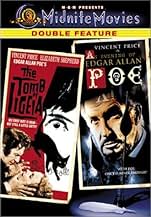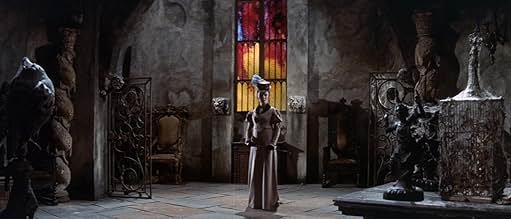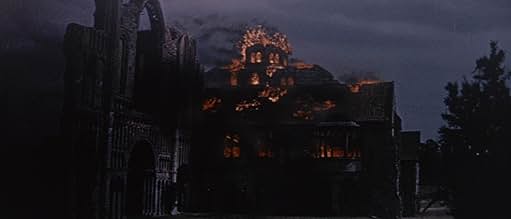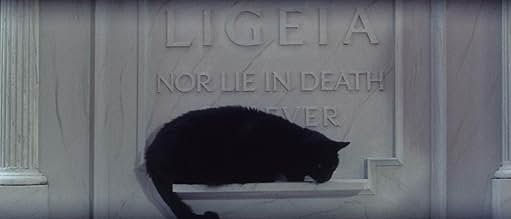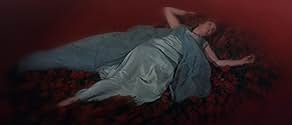CALIFICACIÓN DE IMDb
6.4/10
7.3 k
TU CALIFICACIÓN
La obsesión de un hombre por su difunta mujer abre una brecha entre él y su nueva esposa.La obsesión de un hombre por su difunta mujer abre una brecha entre él y su nueva esposa.La obsesión de un hombre por su difunta mujer abre una brecha entre él y su nueva esposa.
- Dirección
- Guionistas
- Elenco
Maxwell Craig
- Wedding Guest
- (sin créditos)
Anthony Lang
- Wedding Guest
- (sin créditos)
Del Watson
- Footman
- (sin créditos)
Fred Wood
- Wedding Guest
- (sin créditos)
- Dirección
- Guionistas
- Todo el elenco y el equipo
- Producción, taquilla y más en IMDbPro
Opiniones destacadas
Amidst a crumbling castle in 19th century England, a widowed aristocrat (Vincent Price) mourns his wife, but quickly develops a new romantic relationship after meeting the forceful Rowena (Elizabeth Shepherd). Yet the soul of Ligeia seems to be haunting the estate and the apparently mesmerized Baron is hiding something.
Released in late 1964, "The Tomb of Ligeia" is Gothic horror based on the Edgar Allan Poe story from 1838 (which was revised in 1845 with the addition of his 1843 poem "The Conqueror Worm," written by the character Ligeia). This was the last of Roger Corman's eight Poe films from 1960-1964, which all made money but this one made the least, possibly because the quasi-series had run its course and the story was overly complicated. Nevertheless, Corman considered it one of the best of the lot.
Since the original tale was so short, scriptwriter Robert Towne incorporated elements from other Poe stories, such as the black cat, mesmerism and a hint of necrophilia. The talky story isn't as compelling as Corman's "The Terror" (1963) or even "The Masque of the Red Death" (1964). It's rather boring for the first hour, but there's an effectively creepy payoff in the last act, which ties everything together. Like those previous two films, the sumptuous Gothic ambiance is worth the price of admission and the inclusion of Stonehenge is a highlight. You just have to acclimate to the dated drama-focused goings-on.
The movie runs 1 hour, 22 minutes and was shot at Shepperton Studios, just west of London, and Castle Acre Priory north of Swaffham, as well as other spots in England, such as Stonehenge, Polesden Lacey and Polzeath, Cornwall, at the southwest tip of Britain (the beach scene).
GRADE: B-/C+
Released in late 1964, "The Tomb of Ligeia" is Gothic horror based on the Edgar Allan Poe story from 1838 (which was revised in 1845 with the addition of his 1843 poem "The Conqueror Worm," written by the character Ligeia). This was the last of Roger Corman's eight Poe films from 1960-1964, which all made money but this one made the least, possibly because the quasi-series had run its course and the story was overly complicated. Nevertheless, Corman considered it one of the best of the lot.
Since the original tale was so short, scriptwriter Robert Towne incorporated elements from other Poe stories, such as the black cat, mesmerism and a hint of necrophilia. The talky story isn't as compelling as Corman's "The Terror" (1963) or even "The Masque of the Red Death" (1964). It's rather boring for the first hour, but there's an effectively creepy payoff in the last act, which ties everything together. Like those previous two films, the sumptuous Gothic ambiance is worth the price of admission and the inclusion of Stonehenge is a highlight. You just have to acclimate to the dated drama-focused goings-on.
The movie runs 1 hour, 22 minutes and was shot at Shepperton Studios, just west of London, and Castle Acre Priory north of Swaffham, as well as other spots in England, such as Stonehenge, Polesden Lacey and Polzeath, Cornwall, at the southwest tip of Britain (the beach scene).
GRADE: B-/C+
At one point in this film Vincent Price says 'Christopher, not ten minutes ago I tried to kill a stray cat with a cabbage'. Now, I think that is a pretty good reason alone to watch this movie but if that's not enough for you well, its another Roger Corman gothic horror starring Vincent the magnificent, based loosely on an Edgar Allen Poe story. There's nice sets and locations, lush cinematography, an above average script and Price doing what he does best, as well as vegetable-based violence directed at felines.
The genius of Edgar Allan Poe lies in his ability to create atmosphere and to draw us in with the power of his magically evocative language. As not a great deal happens in his stories and his characters are thinly drawn, film adaptors feel obliged to invent, expand, elaborate and embellish and this, the last of Roger Corman's versions of Poe, is certainly no exception. The liberties taken and the additions made by Robert Towne are too numerous to mention and include mesmerism and a hint of necrophilia!
The major change is that the marriage between Verden Fell and his second wife, Lady Rowena, is based upon love and not mutual loathing. Their characters have been fleshed out in the forms of Vincent Price as Fell and the lovely Elizabeth Shepherd as Rowena. Unfortunately Mr. Price's persona and air of mystery are unable to compensate for the fact that he is simply too long in the tooth for the role whilst Rowena's freedom of spirit and sensuality make her overpowering attraction to him faintly ludicrous. It is of course highly unlikely that the film would have received financial backing had Mr. Price not been in it.
As one has come to expect from Mr. Corman this film has excellent production values and art direction and is aided by a strong supporting cast.
Poe died in comparative poverty but his works have supplied a framework by which film-makers have enriched themselves. Mr. Corman especially has helped keep Poe's name alive but one must never lose sight of the original stories which remain, of their type, unparalleled.
The major change is that the marriage between Verden Fell and his second wife, Lady Rowena, is based upon love and not mutual loathing. Their characters have been fleshed out in the forms of Vincent Price as Fell and the lovely Elizabeth Shepherd as Rowena. Unfortunately Mr. Price's persona and air of mystery are unable to compensate for the fact that he is simply too long in the tooth for the role whilst Rowena's freedom of spirit and sensuality make her overpowering attraction to him faintly ludicrous. It is of course highly unlikely that the film would have received financial backing had Mr. Price not been in it.
As one has come to expect from Mr. Corman this film has excellent production values and art direction and is aided by a strong supporting cast.
Poe died in comparative poverty but his works have supplied a framework by which film-makers have enriched themselves. Mr. Corman especially has helped keep Poe's name alive but one must never lose sight of the original stories which remain, of their type, unparalleled.
Well, at least for a little while! His last of eight Poe films as director is (loosely) based on the Poe work of the same name and is a solid metaphorical ghost story. Lady Rowena (the wonderful Elizabeth Shepherd) falls in love with Verden Fell (Vincent Price) despite his strange behavior and questionable past. Soon after their marriage, he starts disappearing, she's menaced by that old Poe stand-by (the evil black cat) and plagued by horrific nightmares involving Verden's deceased former wife Ligeia (also played by Shepherd), whose ghost seems intent on ruining the union. Price, in top hat and strange sunglasses in many scenes (his vision being "dangerously acute"), seems a bit too old for the role, but still manages to come through with an effective performance. Corman has always been underrated for effectively capturing period detail on a limited budget and it's his keen eye for the crumbling ruins, lush green countrysides, oceanfronts and shadowy castle corridors that make much of this film work. Screenplay by future Oscar-winner Robert Towne (CHINATOWN). LIGEIA was Corman's last horror film as director until 1990's FRANKENSTEIN UNBOUND.
I was asked recently if I could name any genuinely scary films made before The Exorcist in 1973. The only titles I could come up with were Rosemary's Baby and Night of the Living Dead from the late '60s. I could suggest many horror titles made before 1970, but none were genuinely flesh-crawling enough to make the list. At the time, I had not seen The Tomb of Ligeia. Now I have seen it and, wow! This is one seriously under-rated gem.
It is one of the many Roger Corman films from this era based on an Edgar Allan Poe story. Intelligently scripted by Robert Towne, and acted to perfection by Vincent Price and Elisabeth Shepherd, this film is a treat from start to finish. Shepherd plays a well-to-do lady in Victorian England who falls in love with a mysterious loner (Price) who resides in a crumbling abbey and seems haunted by memories of his previous (now-dead) wife Ligeia. She marries Price, but her chances of love are blighted by spooky happenings which may be the work of the ghost of his jealous ex-bride.
The dream sequence, featuring a dead fox hidden in a bouquet of flowers and a terrifying metamorphosis midway through a passionate kiss, is a marvellous and memorable scene. All scenes featuring the weird black cat are eerily effective. There's also a wonderfully creepy hypnotism episode. The photography is lovely, with colourful outdoor lensing of a real English abbey and superb blending of light and shadows during the ghostly indoor sequences.
So, if you're after a truly spine-tingling film from before 1970 - here you go!
It is one of the many Roger Corman films from this era based on an Edgar Allan Poe story. Intelligently scripted by Robert Towne, and acted to perfection by Vincent Price and Elisabeth Shepherd, this film is a treat from start to finish. Shepherd plays a well-to-do lady in Victorian England who falls in love with a mysterious loner (Price) who resides in a crumbling abbey and seems haunted by memories of his previous (now-dead) wife Ligeia. She marries Price, but her chances of love are blighted by spooky happenings which may be the work of the ghost of his jealous ex-bride.
The dream sequence, featuring a dead fox hidden in a bouquet of flowers and a terrifying metamorphosis midway through a passionate kiss, is a marvellous and memorable scene. All scenes featuring the weird black cat are eerily effective. There's also a wonderfully creepy hypnotism episode. The photography is lovely, with colourful outdoor lensing of a real English abbey and superb blending of light and shadows during the ghostly indoor sequences.
So, if you're after a truly spine-tingling film from before 1970 - here you go!
¿Sabías que…?
- TriviaShot on a 25 day schedule in the UK, a big difference to the 15 day schedule used in the US for the previous Roger Corman "Poe" movies. The director attributed the extra time to the British crew's obsession with taking "tea breaks."
- ErroresPosition of Ligeia's arms when lying in bed. When Rowena fall on her her arms are in a position like holding something. Few minutes later, when Verden take a look on the bed hidden by the black curtains, their arms are in other position.
- Citas
Verden Fell: Christopher, not ten minutes ago I... I tried to kill a stray cat with a cabbage, and all but made love to the Lady Rowena. I succeeded is squashing the cabbage and badly frightening the lady. If only I could lay open my own brain as easily as I did that vegetable, what rot would be freed from its grey leaves?
- ConexionesFeatured in Nightwatch Presents Edgar Allan Poe: The Tomb of Ligeia (1973)
Selecciones populares
Inicia sesión para calificar y agrega a la lista de videos para obtener recomendaciones personalizadas
Detalles
- Fecha de lanzamiento
- Países de origen
- Idioma
- También se conoce como
- The Tomb of Ligeia
- Locaciones de filmación
- Productora
- Ver más créditos de la compañía en IMDbPro
- Tiempo de ejecución
- 1h 22min(82 min)
- Color
- Relación de aspecto
- 2.35 : 1
Contribuir a esta página
Sugiere una edición o agrega el contenido que falta



